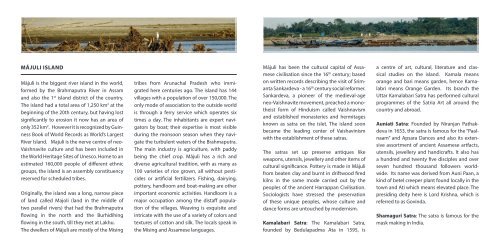ASSAM, INDIA'S TEA GROWING NORTHERN STATE
Create successful ePaper yourself
Turn your PDF publications into a flip-book with our unique Google optimized e-Paper software.
MĀJULI ISLAND<br />
Mājuli is the biggest river island in the world,<br />
formed by the Brahmaputra River in Assam<br />
and also the 1 st island district of the country.<br />
The island had a total area of 1,250 km 2 at the<br />
beginning of the 20th century, but having lost<br />
significantly to erosion it now has an area of<br />
only 352 km 2 . However it is recognized by Guinness<br />
Book of World Records as World’s Largest<br />
River Island. Majuli is the nerve centre of neo-<br />
Vaishnavite culture and has been included in<br />
the World Heritage Sites of Unesco. Home to an<br />
estimated 160,000 people of different ethnic<br />
groups, the island is an assembly constituency<br />
reserved for scheduled tribes.<br />
Originally, the island was a long, narrow piece<br />
of land called Majoli (land in the middle of<br />
two parallel rivers) that had the Brahmaputra<br />
flowing in the north and the Burhidihing<br />
flowing in the south, till they met at Lakhu.<br />
The dwellers of Mājuli are mostly of the Mising<br />
tribes from Arunachal Pradesh who immigrated<br />
here centuries ago. The island has 144<br />
villages with a population of over 150,000. The<br />
only mode of association to the outside world<br />
is through a ferry service which operates six<br />
times a day. The inhabitants are expert navigators<br />
by boat; their expertise is most visible<br />
during the monsoon season when they navigate<br />
the turbulent waters of the Brahmaputra.<br />
The main industry is agriculture, with paddy<br />
being the chief crop. Mājuli has a rich and<br />
diverse agricultural tradition, with as many as<br />
100 varieties of rice grown, all without pesticides<br />
or artificial fertilizers. Fishing, dairying,<br />
pottery, handloom and boat-making are other<br />
important economic activities. Handloom is a<br />
major occupation among the distaff population<br />
of the villages. Weaving is exquisite and<br />
intricate with the use of a variety of colors and<br />
textures of cotton and silk. The locals speak in<br />
the Mising and Assamese languages.<br />
Mājuli has been the cultural capital of Assamese<br />
civilisation since the 16 th century; based<br />
on written records describing the visit of Srimanta<br />
Sankardeva - a 16 th century social reformer.<br />
Sankardeva, a pioneer of the medieval-age<br />
neo-Vaishnavite movement, preached a monotheist<br />
form of Hinduism called Vaishnavism<br />
and established monasteries and hermitages<br />
known as satra on the islet. The island soon<br />
became the leading center of Vaishavinism<br />
with the establishment of these satras.<br />
The satras set up preserve antiques like<br />
weapons, utensils, jewellery and other items of<br />
cultural significance. Pottery is made in Mājuli<br />
from beaten clay and burnt in driftwood fired<br />
kilns in the same mode carried out by the<br />
peoples of the ancient Harrappan Civilisation.<br />
Sociologists have stressed the preservation<br />
of these unique peoples, whose culture and<br />
dance forms are untouched by modernism.<br />
Kamalabari Satra: The Kamalabari Satra,<br />
founded by Bedulapadma Ata in 1595, is<br />
a centre of art, cultural, literature and classical<br />
studies on the island. Kamala means<br />
orange and bari means garden, hence Kamalabri<br />
means Orange Garden. Its branch the<br />
Uttar Kamalabari Satra has performed cultural<br />
programmes of the Satria Art all around the<br />
country and abroad.<br />
Auniati Satra: Founded by Niranjan Pathakdeva<br />
in 1653, the satra is famous for the “Paalnaam”<br />
and Apsara Dances and also its extensive<br />
assortment of ancient Assamese artfacts,<br />
utensils, jewellery and handicrafts. It also has<br />
a hundred and twenty five disciples and over<br />
seven hundred thousand followers worldwide.<br />
Its name was derived from Auni Paan, a<br />
kind of betel creeper plant found locally in the<br />
town and Ati which means elevated place. The<br />
presiding deity here is Lord Krishna, which is<br />
referred to as Govinda.<br />
Shamaguri Satra: The satra is famous for the<br />
mask making in India.

















